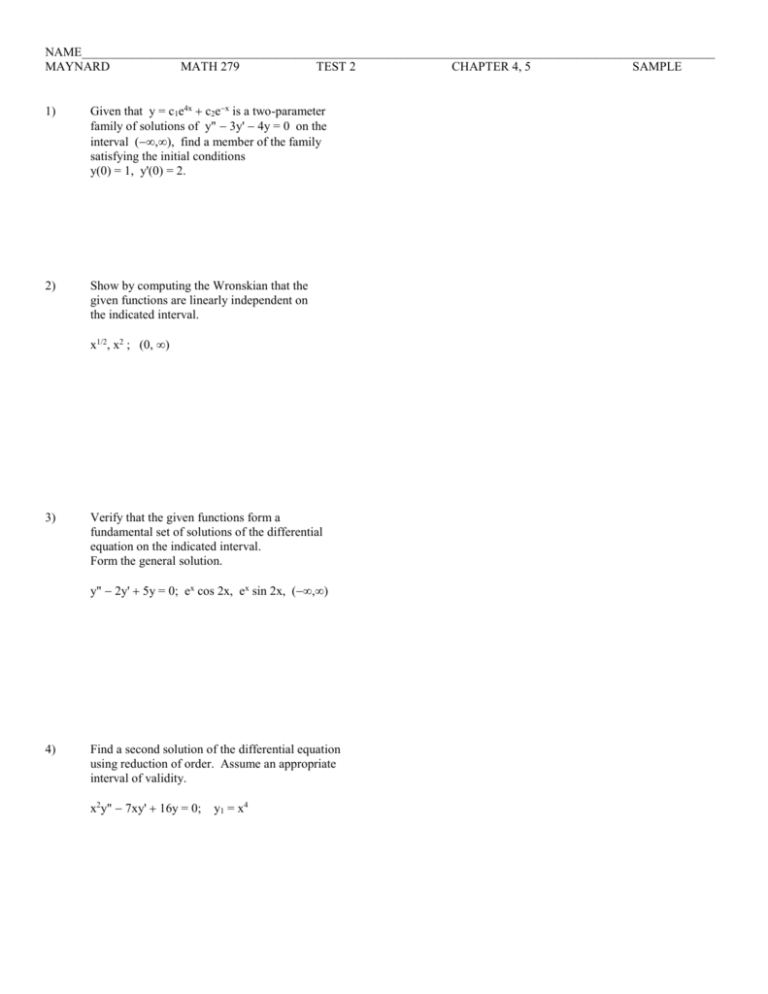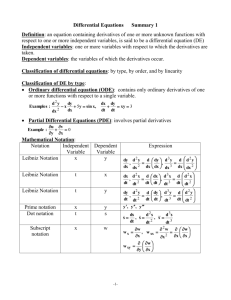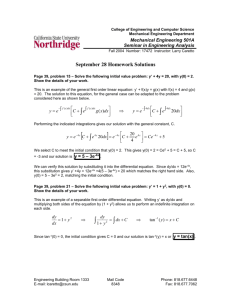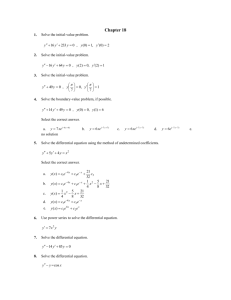NAME
advertisement

NAME_____________________________________________________________________________________________________ MAYNARD MATH 279 TEST 2 CHAPTER 4, 5 SAMPLE 1) Given that y = c1e4x c2ex is a two-parameter family of solutions of y" 3y' 4y = 0 on the interval (,), find a member of the family satisfying the initial conditions y(0) = 1, y'(0) = 2. 2) Show by computing the Wronskian that the given functions are linearly independent on the indicated interval. x1/2, x2 ; (0, ) 3) Verify that the given functions form a fundamental set of solutions of the differential equation on the indicated interval. Form the general solution. y" 2y' 5y = 0; ex cos 2x, ex sin 2x, (,) 4) Find a second solution of the differential equation using reduction of order. Assume an appropriate interval of validity. x2y" 7xy' 16y = 0; y1 = x4 5) Find a second solution of the differential equation using reduction of order. Assume an appropriate interval of validity. (1 2x x2)y" 2(1 x)y' 2y = 0; 6) y1 = x 1 Find the general solution of the differential equation. 12y" 5y' 2y = 0 7) Solve the differential equation subject to the initial conditions. 2y" 2y' y = 0, y(0) = 1, y'(0) = 0 8) Find a differential operator that annihilates the function. 13x 9x2 sin 4x 9) Solve the differential equation by the method of undetermined coefficients using an annihilator. y" y' 12y = e4x 10) Solve the differential equation by the method of undetermined coefficients using an annihilator. y" 2y' 5y = e x sin x 11) Solve the differential equation by the method of variation of parameters. State an interval on which the general solution is defined. y" 3y' 2y = 1/(1 e x ) 12) Solve the differential equation by the method of variation of parameters. State an interval on which the general solution is defined. y" 2y' y = e x ln x 13) The period of free undamped oscillations of a mass on a spring is /4 second. If the spring constant is 16 lb/ft, what is the numerical value of the weight? 14) A 64-lb weight attached to the end of a spring stretches it 0.32 ft. From a position 8 in. above the equilibrium position the weight is given a downward velocity of 5 ft/s. a) Find the equation of motion. b) What are the amplitude and period of motion? c) How many complete vibrations will the weight have completed at the end of 3 seconds? d) At what time does the weight pass through the equilibrium position heading downward for the second time? e) At what times does the weight attain its extreme displacement on either side of the equilibrium position? f) What are the position, instantaneous velocity and acceleration of the weight at t = 3 seconds? A force of 2 lb stretches a spring 1 ft. A 3.2-lb wight is attached to the spring and the system is then immersed in a medium that imparts a damping force numerically equal to 0.4 times the instantaneous velocity. a) Find the equation of motion if the weight is released from rest 1 ft above the equilibrium position. b) Express the equation of motion in the form 15) x(t) Ae λt sin ω 2 λ 2 t φ c) Find the first time at which the weight passes through the equilibrium position heading upward. 16) A 10-lb weight attached to a spring stretches it 2 ft. The weight is attached to a dashpot damping device that offers a resistance numerically equal to ( > 0) times the instantaneous velocity. Determine the values of the damping constant so that the subsequent motion is a) overdamped b) critically damped c) underdamped. 17) A mass m is attached to the end of a spring whose constant is k. After the mass reaches equilibrium, its support begins to oscillate vertically about a horizontal line L according to a formula h(t). The value of h represents the distance in feet measured from L. Determine the differential equation of motion if the entire system moves through a medium offering a damping force numerically equal to (dx/dt) L } h(t) m 18) A mass of 100 g is attached to a spring whose constant is 1600 dynes/cm. After the mass reaches equilibrium, its support oscillates according to the formula h(t) = sin 8t, where h represents displacement from its original position, in cm. a) In the abscence of damping, determine the equation of motion if the mass starts from rest from the equilibrium position. b) At what times does the mass pass through the equilibrium position? c) At what times does the mass attain its extreme displacements? d) What are the maximum and minimum displacements? 19) Find the steady-state charge and the steady-state current in an L-R-C series circuit when L = 1 henry, R = 2 ohms, C = 0.25 farad, and E(t) = 50 cos t volts. 20) Find the equation of motion describing the small displacements (t) of a simple pendulum of length 2 ft released at t = 0 with a displacement of 1/2 radian to the right of the vertical and angular velocity of 23 radians /s to the right. What are the amplitude, period, and frequency of motion? ANSWERS 1) y = 3/5 e4x 2/5ex 1/2 2 3 3/2 a) b) c) d) 19) qp = 100/13 sin t 150/13 cos t; ip = 100/13 cos t 150/13 sint 20) (t) = 1/2 cos 4t 1/2 3 sin 4t; amplitude = 1 period = /2 frequency = 2/ 0 on (0, ) 2) W(x , x ) = /2 x 3) The functions satisfy the differential equation and are linearly independent on the interval, since the Wronskian is never zero on the interval. y = c1ex cos 2x c2ex sin 2x 4) y2 = x4 ln |x| 5) y2 = x2 x 2 6) y = c1e2x/3 c2ex/4 7) y = ex/2 cos ( x /2 ) ex/2 sin ( x /2 ) 8) D3 (D2 16) 9) y = c1e3x c2e4x 1/7 xe4x 10) y = ex (c1 cos 2x c2 sin 2x) 1/3 ex sin x 11) y = c1ex c2e2x (ex e2x ) ln (1 ex) ( , ) 12) y = c1ex c2xex 1/2 x 2 ex ln x 3/4 x 2 ex (0 , ) 13) 8 lb 14) a) x(t) = 2/3 cos 10t 1/2 sin 10t = 5/6 sin (10t 0.927) b) 5/6 ft; /5 c) 15 cycles d) 0.721 s e) (2n 1)/20 0.0927, n = 0, 1, 2, ... f) 0.597 ft; 5.814 ft/s; 59.702 ft/s2 15) a) x(t) = e2t [ cos 4t 1/2 sin 4t] b) x(t) = 1/25 e2t sin (4t 4.249) c) 1.294 s 16) a) > 5/2 b) = 5/2 c) 0 < < 5/2 17) mx" = k(x h) x' or x" (/m) x' (k/m)x = (k/m)h(t) or x" 2x' 2x = 2h(t) x(t) = 2/3 sin 4t 1/3 sin 8t t = n/4, n = 0, 1, 2, ... t = /6 n/2, n = 0, 1, 2, ... 1 /23 cm, 1/23 cm 18)











